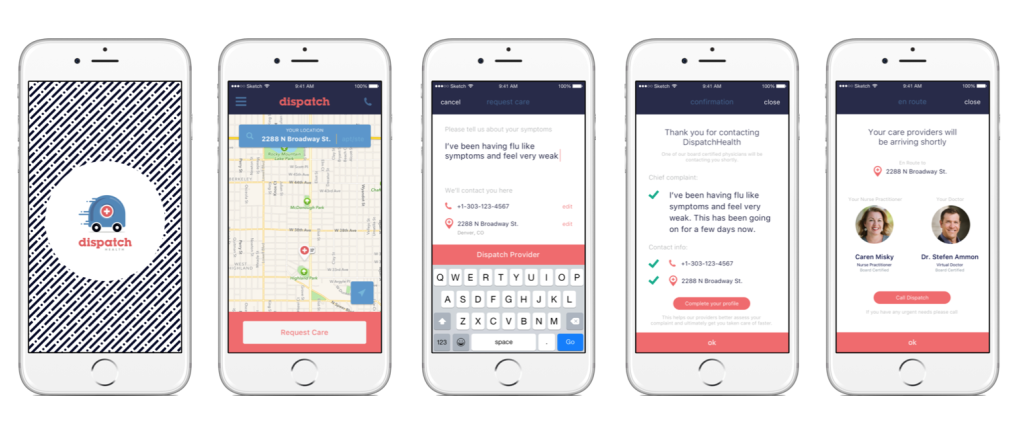DENVER, CO — In 2011, Dr. Mark Prather, a practicing ER physician and the CEO of DispatchHealth, knew that change was on the horizon when he witnessed iTriage delivering healthcare advice through a smartphone app. During that same time, Dr. Prather was working with the finance committee of Centura Health’s Colorado Health Neighborhoods, helping the healthcare system there take its first steps towards value-based care, and noticed that avoidable emergency room visits were at the top of the list of things that providers like Centura wanted to reduce.
“If you make your living running volume through an emergency room,” Dr. Prather admitted, “it sort of makes you nervous about the future.”
Together with Kevin Riddleberger, the CSO of DispatchHealth, Dr. Prather began considering ways of delivering care that would reduce unnecessary visits to the ER. Their discussions were influenced by recent developments in the world of EMS, where providers were becoming increasingly interested in doing more than just transporting patients to the hospital.
“We got lucky because we were thinking about all of this in 2013, and South Metro Fire Rescue approached us and said, ‘We would like to deliver care differently, and we would like to do it with you.”
Working with South Metro Fire Rescue allowed Dr. Prather to take his ideas and put them into practice. After a year-long pilot, he and Riddleberger launched DispatchHealth, an acute care delivery service that takes many of the testing and procedures normally performed in the emergency room – including labs, IVs, and stitches – and puts them in the back of a car.
“We began interfacing with the 911 system in 2013 and treating people,” Dr. Prather explained. “During our pilot phase, we pulled almost five hundred people out of the system.”
DispatchHealth has been in operation ever since, delivering acute care to patients in the comfort of their own homes, and saving the healthcare system millions of dollars in the process.
Acute Care in the Comfort of Home
When a patient contacts DispatchHealth, they speak to a representative who identifies the level of care that the patient requires. If the patient doesn’t need to go to the emergency room, then a DispatchHealth team is sent to the patient’s home or place of work.
Once they’ve arrived, the DispatchHealth team – which is generally composed of a nurse practitioner and an EMT – is able to treat a range of ailments, whether respiratory, musculoskeletal, or gastrointestinal. The team is also prepared to perform a wide variety of procedures, including inserting catheters, dressing wounds, and even ordering X-rays.
“If the individual who contacts us is immobile or would have a difficult time getting to the imaging centers that we partner with,” explained Dr. Prather, “then we can bring the imaging equipment out to the home and take the X-rays there.”
According to the company’s website, the average DispatchHealth visit costs two hundred dollars – or eighteen hundred dollars less than a visit to the ER. Patients who use the service also get three times as much face-time with a clinician as they would were they to visit the emergency room.
While Dr. Prather associates DispatchHealth’s low readmission rates with his company’s ability to spend enough time with patients to gain a comprehensive sense of their ailments, he also attributes the advanced level of care that DispatchHealth is able to deliver to the progressive miniaturization of medical technology.
“If you look at the history of the house call, in 1940 we provided 60% of care in the home. That went to about zero when I trained in the late 80s, because to make an accurate diagnosis, you had to go to a large facility to have labs and other testing performed. That’s all changed now because everything has gotten smaller and you can fit it all in the back of a vehicle.”
A New Way to Deliver Care
DispatchHealth’s ability to deliver high-quality care at a low cost in the convenience of a patient’s home has created a small but loyal consumer base that continues to grow. Yet a current obstacle to broader adoption of the service is the lack of widespread awareness among the general public that house calls can provide comprehensive medical care.
“When we talk to one of our senior communities and tell them, ‘We’re delivering house calls,’ a light bulb shines and they say, ‘I remember when I received care that way,” explained Riddleberger. “But when you tell this to younger individuals, they don’t really understand what you’re talking about.”
As DispatchHealth continues to widen its consumer base, that awareness is steadily growing. In an effort to further spread the word about its services, the company regularly features patient feedback on its blog.
“This healthcare experience was so simple, I am still a little blown away,” wrote Paige Damiano, whose three-year old son had been treated by DispatchHealth for a dislocated elbow. “It truly couldn’t have gone any more simply.”
According to Riddleberger, DispatchHealth’s net promoter score (NPS), an objective score that helps companies gauge customer loyalty, is currently at a remarkable 95 out of 100. While Riddleberger believes that the simplicity, convenience, and comfort of the DispatchHealth experience are responsible for the company’s high NPS, Dr. Prather sees it boiling down to ease of access.
“Access to care is a big issue for a lot of people in the United States, and that’s really why we have costs that are out of control. There are great stats on how long it can take members of the Medicaid population to obtain a primary care appointment. But if their baby is sick or if they have an uncomfortable bladder infection, can they really wait two weeks to see a doctor? That’s why they end up in the emergency room.”
Improving Healthcare, Not Disrupting It
Though DispatchHealth clearly represents a departure from the healthcare status quo, neither Riddleberger nor Dr. Prather view themselves as disruptors.
“Everyone wants to disrupt healthcare, and I’m really not a big fan of that term,” admitted Dr. Prather. “Healthcare works. We’ve been improving longevity for a long time. We can open up blocked vessels around your heart. We just need to fix delivery issues and enhance the experience for the healthcare consumer.”
“We’re taking the existing system,” added Riddleberger, “and improving it so that it delivers the right care, at the right place, at the right time.”
Like the coverage that CyberMed News provides? Follow us on Twitter, LinkedIn, and Facebook to make sure you keep up to date on the most recent developments in digital health.







Be the first to comment on "Keeping Patients Out of the ER by Bringing Back the House Call"